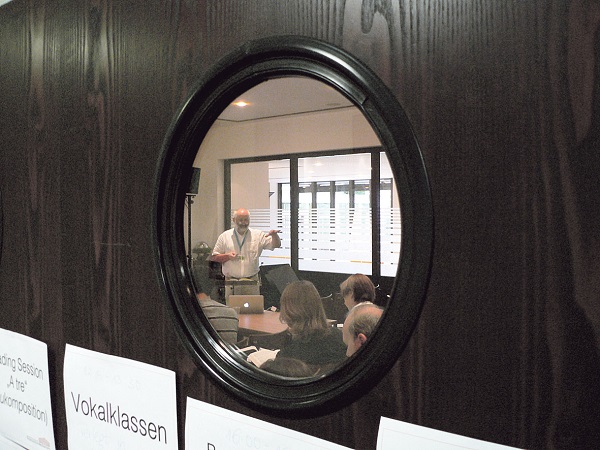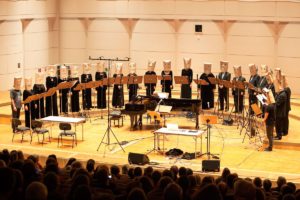By Juan Martin Koch, musicologist and journalist
“Take throngs of people, take them in their hundreds, their thousands, and help them indulge in humane interaction, interaction, where each individual may exercise freely his personality, not just by expression but in words too, where he simultaneously receives homogeneous impressions, where his sense of human autonomy is inculcated and he, in the most intuitive and various ways, is aware of being educated, and where he emanates and expirates love with each breath – do you have anything other than choral singing?”
It was with some sense of glee that Friedhelm Brusniak – an expert in the history of the choral movement in Germany – served up this quote by Hans Georg Nägelis from the year 1809; it would have been a tad more exciting if he had been addressing not the hand-picked participants of the Research Symposium on the Choral Movement (who will surely have known it beforehand), but the broader community of choral enthusiasts gathered on the occasion of the very first ‘chor.com’ in Dortmund [Ed. 22-25 September 2011].
And why exactly would that have been more exciting? Well, a mere glance at the history of this movement from the beginning of the 19th century onwards would have conveyed to the audience a sense of exactly that tradition in which it was steeped – be it deliberately or unintentionally – and certainly despite the teenager-friendly, intercultural moniker. Could this have perked up our ears and helped us home in on the German word gesellig, denoting here unfortunately a sense of folksy conviviality, and which the Managing Director of the host organisation, the Singers Guild of Westphalia, had somehow managed to include in the typescript of her somewhat maladroit opening speech. It would at least have opened up some new directions and harnessed perhaps the collective, if legitimate, euphoria that was to mark ‘chor.com’ on this, its very first outing.
A trade fair? A meeting point for the industry? A congress? A festival? Fine, but only as long as such an event can not be tied to a particular function, and only if it manages to be all this and more, and only if it believes its visitors are capable of fulfilling other aims than traipsing past the various booths to avail themselves of a few give-aways and dropping in on workshops for a few homespun recipes along the lines of ‘Pimp Your Choir’. The German Choral Association had obviously listened very closely to its disparate membership and multipliers of information – mainly choral directors – and had put together a bespoke programme.
The readiness with which around 1000 official participants embraced the event – there were 120 workshops and over 50 exhibitors – was readily apparent: one gathered that there was immense enthusiasm amongst those attending, without any sense of ensuing dissipation. The unofficial yield from a plethora of ad hoc discussions at the many venues spoke for itself. The actual concerts were exquisite offerings indeed, and the radio choirs from Cologne and Berlin, as well as the ‘Night of the Choirs’ with its 30 events plus, allowed the entire panoply of the choral repertoire to unfold, from Gregorian chant up to contemporary music.
But before we all indulge in an obligatory rendering of the Hallelujah Chorus in praise of the choral landscape in present-day Germany, it seems there is a pressing need for a few more rehearsals. The introductory press conference, accompanied as it was by an ‘Opening in Song’ suffered greatly from a simple lack of information and pithy content, and lost any impact it might have had in the public domain. We noted with interest, however, the spontaneous decision by the President of the German Choral Association (Deutscher Chorverband, DCV), Dr Henning Scherf, to bring Dr Regina Görners, President of the Consortium of German Choral Associations (Arbeitsgemeinschaft Deutscher Chorverbände, ADC) into the fold. Nevertheless the DCV has announced its withdrawal from the ADC at the end of 2011. And with over one million members, of whom approximately 750,000 are active singers in around 27,000 choirs, the ADC has lost by far the most important and the largest of the various choral federations in Germany. With the DCV no longer part of the ADC, the latter’s role is clearly weakened and its existence as both a conglomerate of choral federations and an umbrella organisation for smaller associations actively promoting amateur choral music must now be questioned.
At the core of today’s choral life in Germany there is a current of optimism, despite the sheer amount of work still left to be done: Peter Brünger made this very clear in his presentation on the average age, educational level, and professional or occupational backgrounds of singers in the field of amateur choral music. New measures it seems could do much to win over parts of society previously far removed from choral activities, despite demographic changes taking place in our own times.
Nonetheless, the focus of these efforts has to be on strengthening the role of singing in childhood and adolescence, possibly the most important task in the field of musical education. And even Brünger’s partial evaluations gained from a recent study provided additional arguments. It was then, quite a visionary decision taken by two key figures responsible for the development and implementation of the first ‘chor.com’ – Veronika Petzold and Moritz Puschke – to ensure that projects already up and running in various places throughout Germany would be represented in order to facilitate an exchange of information and encourage best practice. A good example of this are the many kindergartens in Germany with strong singing programmes, despite the odd name for the seal of quality they might in future be awarded by the DCV, the ‘Caruso’ – a tag that might surely be revised.
As for the final discussions, opinions diverged as to how exactly such diverse initiatives and trends could be harnessed to reach the same objectives. Pedagogical orientation varies widely, and there is a need for a single movement with real ‘clout’ that would act nationwide. There was however broad agreement that mere words and verbose appeals will not help matters. The vast majority of participants recognised a need for joint action, coordinated by the DCV, which at a political level would not allow those in power to fly in face of the facts, but would help mobilize broad sectors of the population.
But what music will we be singing if all these activities really do create such a thing as a mature choral movement of the 21st Century? It was a special stroke of luck that the Choir of the West German Radio Cologne (WDR Rundfunkchor Köln) under Rupert Huber answered precisely this question with its opening concert. He inculcated in the audience a heightened sensitivity to an important and sometimes neglected historical repertoire, music sung by a kind of choir that came into being in the 19th Century in Germany and known as a Sängertafel, or ‘Singing Society’ (lit. Singers Board). But the conductor explored too the type of works sung by men’s and women’s choirs, the Männerchöre and Frauenchöre which played such an important role in this period. Only from this perspective is it possible to gauge what might be viewed as ‘singable’ today. Whether it really meant a democratization of the singers as they were called upon to deliver according to the improvisations of a singer who ‘lined out’ the music, a Vorsängerin in this case, as opposed to following a baton or the beat of a hand, remains an open question, although the contagious charisma of one Natascha Nikeprelevic will remain in our collective memory.
The stimulating encounter with the rappers Maeckes & Plan B produced no new masterpiece where serious music and light music merged, but placed a salutary question mark behind any mindless choral euphoria. These two young musicians, with their at times perverse texts, certainly made that point clear as they wandered over to the WDR choir during the opening concert only to place a paper bag over each singer’s head, the muffled effect intentional of course.
It is planned to hold ‘chor.com’ as a biennial congress, and the DCV has clearly given German choral life exactly the kind of event it has needed for so long. And if a National Choral Centre should become a reality in Berlin – the tireless efforts of an always credible Henning Scherf made the notion of ‘Chor@Berlin’ more concrete in conversation with Theo Geißler – then a true ‘Renaissance of the choral art’, as promised by Simon Halsey, will gather up all before it. The task remains as to how this can be kept on the move.
Translated from the German by Graham Lack
This article first appeared in the German language in: neue musikzeitung 10/2011
Used by permission.



